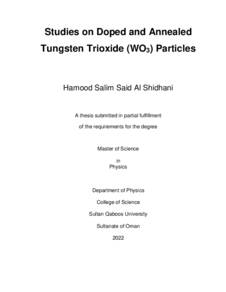وثيقة
Studies on doped and annealed tungsten trioxide (WO3) particles.
عناوين أخرى
دراسات على ثالث أكسيد التنجستن (WO3 ) المطعم والمعالج بالحرارة
الناشر
Sultan Qaboos University.
ميلادي
2022
اللغة
الأنجليزية
الموضوع
الملخص الإنجليزي
Nanostructured metal oxides such as ZnO, TiO2, SnO2 and WO3 are essential in sensor
applications due to their electrochemical properties and large chemically active surface.
Tungsten (VI) trioxide (WO3) in particular, is a promising semiconductor due to its
occurrence in different crystal structures (e.g., cubic, orthorhombic, monoclinic, etc.) with
bandgaps in the range (~2.5−3.6 eV). However, WO3 has a low emission quantum yield at
room temperature due to the non-radiative recombinations. Moreover, it has been reported
that increasing the active surface of WO3 enhances its application potential. Another exciting
aspect of WO3 is the oxygen vacancy-related photoluminescence centers. Electrochromic
phenomenon (EC) is a phenomenon in which the optical properties (light absorption and
emission) of materials change when counter balanced charges are injected or extracted from
the material. WO3 is one of the most extensively studied electrochromic material and it is
commonly used as an EC layer in smart windows. The EC of WO3 is found to depend on the
type and concertation of impurities present in the lattice. It also depends on the concentration
of oxygen vacancies. The stoichiometric WO3 has W6+
ions in the lattice. The presence of an
impurity atom (electron donating) or an oxygen vacancy can create excess electrons in the
lattice. These electrons can be localized on the 5d orbitals of W6+ cations.
This leads to creating W5+ (in doped) or W5+ and W4+ (sub-stoichiometric) ionic states.
Previously it was thought that the optical properties shown by WO3 are related to
photoinduced charge hopping from W5+ to neighboring W6+
ionic states. Later reports tried
to explain EC based on the polaron hopping due to the presence of lattice distortion.
However, all these models could not explain the effect of oxygen vacancies on the EC
characteristics of WO3. Recent publications suggest that oxygen vacancies play a crucial role
in the occurrence of EC. The crystal direction in which the oxygen vacancy is formed is also
important. This is because the bond length and angle can be different in the three crystal
directions, for example in monoclinic WO3. The oxygen vacancies can exist in three different
charge states and optical properties can be explained based on the transitions between
v
vacancy charge states. There are a lot of theoretical and experimental studies related to
emission from the monoclinic WO3 phase. However, this is not the case with the
orthorhombic phase of WO3. This project aims to synthesize and study the pure and doped
orthorhombic phase of WO3 by different characterization techniques such as XRD, XPS,
TEM, SEM, PL, UV-visible, etc. The high-temperature annealing of WO3 shows a structural
phase transition from orthorhombic to monoclinic. The emission centers of the monoclinic
structure are identified from the theoretical predictions of charge transition levels (CTL). We
also show the experimental CTL, which can be used as a reference for the theoretical
calculations of the orthorhombic phase. Al doping changes the bandgap and reduces emission
intensity due to missing transitions compared to the undoped sample. This is attributed to the
increased levels of non-radiative pathways in the doped samples.
المجموعة
URL المصدر
قالب العنصر
الرسائل والأطروحات الجامعية

